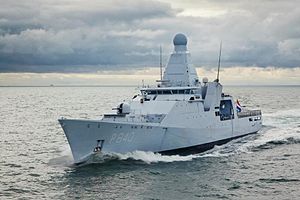Lumber said:
Why we don't have a Harpoon capability on our Auroras I do not understand! I think* the CF-18s are equipped for it, but they never ever train for it, am I correct?
Anyways, your whole point about the ships on station being forward observers is also part of what I was alluding to "contemplating" earlier. You can carry a lot more missiles (TLAM or Anti-Ship) aboard submarines, and if you are using air-assets, those can return to base, re-arm, and return FAR faster than a ship could. Hell, in a few decades, you could use shore-based anti-ship missiles with ranges of a thousand kilometres (just a theory).
So, all you would need was forward observers to designate targets, and in these cases, if all you need is eyes and sensors, then large, expensive, heavily crewed warship might not be the best tool.
That being said, there is nothing more imposing than the arrival of a CBG off your coast. That has a quality all in it's own.
Actually incorrect, Lumber. First of all, most submarines only carry torpedoes - not missiles. But for argument sake, let's look at some submarines that do carry them, and look at large submarines that carry them to maximize the carrying capability, and compare to equivalent surface ships. For reference sake: They are all in the 8000 to 9000 tons range for displacement - so comparable.
The Brits Astute class submarines can carry a maximum combined (for each missile you load one torpedo has to be unshipped) of 38 missiles and torpedoes. It costs 3USB$ per boat. Meanwhile, the Type 26 frigate (GP version), costing you 1.2USB$ each, will carry 72 missiles plus 14 torpedoes - total of 86.
On the US side, let's look at the most advanced version of the Virginia SSGN (since it carries the most), which carries a combined maximum load of 65 missiles and torpedoes (earlier Virginias carried a max of 50 ), at the very reasonable cost of 2.7USB$ per boat, while the latest incarnation of the Arleigh Burke destroyers carries either 96 or 104 (depending on wether they have eight tubes for harpoons or not) missiles plus 18 torpedoes, for a total of 114 to 122, the whole at the bargain price of 1.8USB$ each.
So: No, submarines do not have a greater embark capability than surface ships for missiles and, on top of that, are not cheaper than the surface ships they would "replace'.
But, I would like to ask the following two questions to those here who argue for "swarms" of smaller vessels:
1) Considering that the cost of modern warship is 40% in the hulls and propulsion and 60% in the actual weapons, weapons system and combat systems, and that by necessity, your swarm would carry more weapons (your objective) in more weapons systems (launchers) and require more combat systems (for instance in your 10:1 ratio of swarm fighter to frigate, assuming 4 ASW version, 4 AAW versions and 2 ASuW version, would you not require at least 4 good air search radars, vs the 2 on a frigate, 10 navigation and surface search radars, vs the 2 on a frigate and four sonar suites as opposed to one on the frigate) where do you get any savings?
2) Considering that, in Western navies, the largest part of the fleets already consist of the frigates/destroyers class of ships, forming the largest part of the fleets, supporting a much smaller number of larger cruisers, aircraft carriers and amphibious assault ships, and that these ships usually work in Task Force, or Groups, don't we already have a "swarm" system for fighting at sea?






